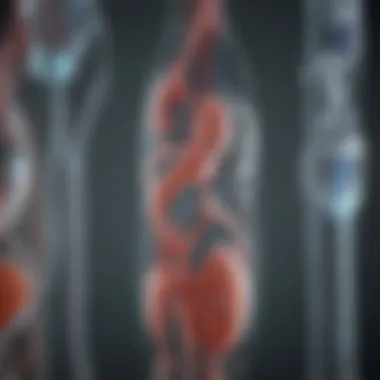Understanding Urination Patterns in Dialysis Patients


Intro
Understanding the complexities of urination in individuals undergoing dialysis is crucial. Patients often experience unique patterns that reflect their specific health conditions and treatment modalities. This section serves as an initial overview of these urination patterns, laying the groundwork for a more detailed exploration.
Dialysis, a life-saving treatment for those with renal failure, poses significant impacts on the body’s natural functions, including urinary output. It is essential to dissect the physiological processes involved and how they interact with factors like fluid management, medication regimen, and individual health status. A comprehensive understanding can improve patient care and inform healthcare providers about the underlying issues faced by their patients.
In the sections that follow, we will delve into the research findings and the methodologies employed in studies regarding urination patterns among dialysis patients, encouraging a clearer understanding of this complex issue.
Understanding Dialysis
The concept of dialysis holds significant relevance in the management of individuals with compromised kidney function. It is crucial to understand how dialysis works, as this informs the physiological changes and health outcomes experienced by patients. This section aims to clarify the essential aspects of dialysis, its different types, and the mechanisms behind its operation. A thorough comprehension of these elements is vital, given that they directly influence a patient's urination patterns and overall health.
Definition and Purpose
Dialysis is a medical treatment designed to perform the essential functions of the kidneys when they can no longer do so effectively. The primary purpose is to remove waste products, excess fluid, and electrolytes from the blood. This process is indispensable for maintaining homeostasis in patients with renal failure. By understanding the definition and purpose of dialysis, healthcare providers can better guide patients regarding their treatment options and what to expect during their dialysis journey.
Types of Dialysis
Dialysis is broadly classified into two main types: Hemodialysis and Peritoneal Dialysis. Each type has its distinct methodologies and implications for patient care.
Hemodialysis
Hemodialysis is the most commonly utilized form of dialysis. In this treatment, a machine is used to filter waste and excess fluids from the blood. A key characteristic of hemodialysis is its reliance on a dialyzer, often referred to as an artificial kidney, which plays a central role in cleansing the blood.
Hemodialysis is a beneficial choice for many patients because it usually requires only three sessions per week, each lasting around four hours. This schedule is often more convenient for patients who may have rigid schedules or limited time for self-care.
However, hemodialysis also presents certain disadvantages. It can lead to fluctuations in blood pressure and may cause complications such as blood clots or infection at the access point. Understanding these aspects of hemodialysis is essential, as they directly affect a patient's overall well-being and urination patterns.
Peritoneal Dialysis
Peritoneal Dialysis utilizes the body's peritoneum as a filter for waste removal. A key characteristic of this method is its use of a sterile solution called dialysate, which is introduced into the abdominal cavity. This allows waste products to diffuse from the blood into the dialysate, which is then drained away.
One prominent advantage of peritoneal dialysis is its flexibility. Patients can often perform the procedure at home, allowing for a more comfortable and autonomous treatment. Additionally, it generally allows for better preservation of residual kidney function compared to hemodialysis.
Nonetheless, peritoneal dialysis is not without its challenges. It requires strict hygiene practices and can lead to complications such as peritonitis, an infection of the peritoneum. An understanding of these pros and cons aids in making informed decisions about which dialysis modality may be most suitable for a specific patient.
Mechanism of Action
The mechanism of dialysis centers on principles of diffusion and osmosis to remove waste products from the blood. During hemodialysis, blood is circulated through a dialyzer where diffusion occurs, allowing smaller waste molecules to cross into the dialysate while retaining larger molecules like proteins and blood cells. In peritoneal dialysis, diffusion occurs across the peritoneal membrane, facilitating the exchange of waste products without the need for specialized machines.
Understanding the mechanics of dialysis is key to appreciating its impact on bodily functions, including urination. By recognizing how effectively these processes operate, healthcare providers can better tailor treatment plans that consider a patient's individual needs, including fluid management and potential outcomes related to urinary function.
Kidney Function and Urine Production


The kidneys play a crucial role in maintaining homeostasis within the body. They contribute to multiple vital processes, including the regulation of bodily fluids, the excretion of waste products, and the balance of electrolytes. Understanding kidney function and urine production becomes especially important for those on dialysis, as these processes are significantly altered in patients with compromised renal function.
Normal Renal Physiology
In a healthy individual, the kidneys filter blood, remove waste products, and produce urine. Each kidney contains approximately one million nephrons, which are the functional units that carry out filtration. The process begins with glomerular filtration, where blood enters the nephron and waste is separated from the nutrients. This is followed by tubular reabsorption, where essential substances like glucose and certain ions are absorbed back into the bloodstream. Finally, tubular secretion occurs, where additional wastes are added to the filtrate, eventually leading to urine formation.
The normal volume of urine produced can reflect an individual's hydration status, dietary intake, and overall health. Generally, a healthy adult excretes about 800 to 2000 milliliters of urine per day, a range influenced by fluid intake and environmental conditions.
Pathophysiology of Kidney Disease
Kidney disease alters the dynamics of waste removal and fluid management. Conditions such as diabetes and hypertension can lead to chronic kidney disease, where kidney function progressively declines. As renal function deteriorates, the ability to filter blood diminishes. This often results in increased levels of toxins and excess fluid buildup in the body, which can lead to complications like edema or hypertension.
Patients in the end-stage of kidney disease often require dialysis. With hemodialysis, the blood is cleansed through a machine, while peritoneal dialysis uses the patient's abdominal cavity as a filtering membrane. In both instances, urine production may cease or significantly decrease. Understanding these physiological changes helps healthcare providers adjust treatment plans and fluid restrictions effectively.
Fluid Balance and Electrolyte Regulation
Maintaining fluid balance and regulating electrolytes are fundamental functions of the kidneys. They control the body's volume status by adjusting how much water is retained or excreted. In patients with kidney disease, these regulatory mechanisms are impaired. For instance, sodium and potassium levels must be closely monitored. Over-retention of these electrolytes can lead to serious health issues, such as cardiac arrhythmias.
Dialysis attempts to replicate these kidney functions by removing excess fluids and maintaining electrolyte balance. It is essential for patients undergoing dialysis to adhere to fluid and dietary restrictions, as failure to manage intake can lead to complications.
In summary, kidney function and urine production are closely intertwined, particularly in individuals undergoing dialysis. Knowledge of normal renal physiology, the effects of kidney disease, and the importance of fluid and electrolyte balance provides critical insight into the management of these patients. This understanding is necessary not only for medical professionals but also for patients navigating their treatment options.
Urination in Dialysis Patients
Understanding urination patterns in dialysis patients is crucial for both medical professionals and patients themselves. This section addresses the complexities and health implications associated with urination in those undergoing dialysis. Recognizing these patterns can aid in proper treatment, fluid management, and enhance overall quality of life for patients. There are various factors that influence how much a patient can urinate, and it is important to be aware of these nuances.
Can Dialysis Patients Urinate?
Many individuals may wonder if patients undergoing dialysis can still urinate. The answer is yes, but the ability to do so varies significantly. Some dialysis patients retain some renal function, allowing for urine production, while others may not produce any urine at all. This lack of urine output can create practical issues regarding fluid management and balance within the body. It is essential to assess a patient's residual kidney function to understand their urination capability and adjust treatment plans accordingly.
Factors Affecting Urine Output
Urine output in dialysis patients can be influenced by several factors. Understanding these can help manage and potentially improve a patient's condition.
Residual Kidney Function
Residual kidney function refers to the remaining ability of the kidneys to filter waste, which can still occur even in patients on dialysis. This aspect is significant as it allows for some level of urine production. The presence of residual kidney function can be beneficial. Some studies indicate that patients with some remaining kidney function often experience better health outcomes. However, it is important to note that this can vary greatly between patients, leading to diverse experiences with urination among those on dialysis.
Type of Dialysis
The type of dialysis undergoing by patients also greatly impacts urine output. Hemodialysis and peritoneal dialysis have different mechanisms of action. Hemodialysis typically involves more aggressive removal of waste and excess fluid, often leading to little to no urine production. In contrast, peritoneal dialysis is less intensive and might allow for some measure of residual kidney function, thereby facilitating some urine output. Understanding these differences is crucial in evaluating urine patterns.
Fluid Intake
Fluid intake is another significant factor that influences urine output. Patients are often advised to limit fluid intake to manage fluid balance effectively. However, those with some residual kidney function might still benefit from a careful increase in fluid intake, allowing for some urine production. Balancing hydration is complex, and patients must work closely with healthcare providers to navigate their specific needs.


Variability Among Individuals
Urine output and patterns can vary widely among dialysis patients due to individual characteristics. This variability emphasizes the need for personalized approaches to treatment.
Patient Characteristics
Individual patient characteristics play a vital role in determining urination patterns. Age, gender, and body mass can influence kidney function as well as the overall health outcomes for dialysis patients. Recognizing these characteristics can help tailor treatment plans that accommodate each individual's specific needs, leading to improved management of dialysis and resulting urination patterns.
Underlying Health Conditions
Underlying health conditions further complicate the picture of urination in dialysis patients. Conditions such as diabetes and hypertension are common in individuals requiring dialysis and can affect kidney function significantly. Addressing these conditions is often key to improving urine output. Timely intervention regarding underlying health issues can lead to better overall health management for patients.
It is critical to monitor and address factors influencing urination in dialysis patients to enhance their treatment and quality of life.
In summary, understanding urination patterns in dialysis patients is complex and multifactorial. By exploring the factors affecting urine output and the variations among individuals, healthcare providers can better manage treatment and improve patient outcomes.
Clinical Implications
Understanding the clinical implications of urination patterns in dialysis patients is crucial for several reasons. First, monitoring urine output can inform healthcare providers about a patient's residual kidney function. This residual function can play a critical role in creating tailored treatment plans that improve patient outcomes.
Additionally, urine output serves as an indicator that can reflect the overall fluid status and kidney health of the patient. In dialysis, where fluid management is essential, precise monitoring can help prevent complications associated with both underhydration and overhydration.
Clinical implications also extend to the psychosocial aspects of patient care. A deeper comprehension of the factors influencing urine output helps healthcare professionals understand the emotional and mental impacts on their patients, guiding them in providing holistic care.
"Understanding urinary patterns can lead to improved quality of life by allowing for more personalized treatment strategies."
In summary, grasping these clinical implications enables a more effective approach to managing the health of patients undergoing dialysis, emphasizing both medical and emotional dimensions.
Monitoring Urine Output
Monitoring urine output in dialysis patients is essential not only for assessing kidney function but also for managing overall health. This practice provides crucial data that may lead to immediate adjustments in treatment plans. It includes observing the volume and characteristics of urine produced between dialysis sessions.
Regular monitoring can also identify trends or abnormalities, such as a sudden decrease in output that may signal an issue. This can prompt further investigations, ensuring that potential complications are addressed in a timely manner. Monitoring practices can take various forms, such as:
- Daily volume measurements to track changes
- Consistency and color examination for potential abnormalities
- Patient feedback on urination patterns to correlate with clinical findings
Incorporating technology to assist with monitoring, such as smartphone apps or wearable devices, can enhance the efficiency of this process. Ultimately, consistent monitoring serves as a bedrock for effective patient management and can foster better health outcomes.
Impact on Treatment Plans
The impact of urination patterns on treatment plans cannot be overstated. Residual kidney function plays a vital role in guiding dialysis modalities and schedules. For instance, patients with some kidney function may require less frequent dialysis sessions, while those with reduced or absent function may need increased frequency.
Furthermore, understanding a patient’s urine output can influence fluid management strategies. Overhydration or underhydration can lead to significant complications, including hypertension and fluid overload. Adjusting dialysate composition and treatment duration may also be warranted based on urine production.
Other considerations include:


- Medication adjustments based on how the body processes drugs through urine
- Nutritional recommendations that take into account fluid restrictions
- Patient education, emphasizing the importance of symptom monitoring and reporting
Quality of Life Considerations
Quality of life is a critical aspect of health management for individuals undergoing dialysis. The experience of managing renal failure and its consequences can significantly affect daily life, including emotional well-being, social interactions, and overall satisfaction. It is essential to understand the interplay between physiological challenges and their psychosocial impact on patients.
Maintaining a sense of normality is crucial. Patients may face numerous adjustments, but acknowledging their concerns and addressing them can enhance their quality of life. Also, effective communication with healthcare providers plays a pivotal role. Patients who feel supported and valued often report better emotional outcomes and increased adherence to treatment regimens.
Psychosocial Aspects
The psychosocial dimensions of dialysis treatment are as important as the physical medical interventions. Patients may experience feelings of anxiety, depression, or isolation. These elements can stem from the life-altering nature of the disease and the lifelong commitment to dialysis. Factors such as previous health status, current social support systems, and personal coping mechanisms can influence emotional health.
In addition to mental health challenges, social life may change due to treatment schedules and symptoms. A strong support system can alleviate feelings of loneliness and reinforce a patient’s resilience. Healthcare providers can assist by encouraging patient participation in support groups or therapy designed for individuals facing similar experiences.
Challenges and Coping Strategies
Living with the reality of renal disease and undergoing dialysis presents several challenges. Patients might struggle with dietary restrictions, fatigue, and coping with frequent medical appointments. These difficulties can lead to frustration or decreased motivation, which can further impact their mental health.
To manage these challenges effectively, patients can utilize various coping strategies:
- Setting Realistic Goals: Patients should set achievable goals regarding their health and daily activities. Small victories can uplift one’s spirit.
- Establishing Routines: Creating a daily schedule can help manage time more effectively and reduces feelings of being overwhelmed.
- Seeking Education: Knowledge about their condition can empower patients. Understanding dialysis processes and their body's responses can alleviate fears and uncertainties.
- Building a Support Network: Engaging in discussions with family, friends, and support groups provides emotional relief and may foster a sense of community.
By developing tailored coping mechanisms and focusing on psychosocial well-being, patients can improve their overall quality of life while navigating the complexities of dialysis.
Key Takeaways
Understanding the patterns of urination in individuals undergoing dialysis is crucial for both patients and healthcare providers. These patterns can significantly affect treatment plans, fluid management, and overall quality of life. Below are the specific elements that highlight the importance of this topic:
- Physiological Understanding: Recognizing how dialysis affects kidney function gives insight into urine production levels.
- Patient Variability: Each patient's experience can differ. Factors such as residual kidney function and underlying health conditions play a role.
- Fluid Management: Effective monitoring of urination helps manage fluid intake, crucial for preventing complications associated with fluid overload.
- Quality of Life: Addressing urination patterns can improve psychosocial aspects of patient life, including emotional well-being and social interactions.
Overall, shedding light on these takeaways can lead to better management strategies and improved outcomes for individuals undergoing dialysis.
Summary of Findings
The article reveals several key insights:
- Not all dialysis patients cease to urinate. Some retain a degree of kidney function that allows for urine production.
- Fluid intake, type of dialysis, and residual kidney function are primary factors that influence urine output in patients.
- Individual characteristics, including age, gender, and comorbidities, contribute to variance in urinary patterns among patients.
The findings underscore the complexities of urinary function in dialysis patients and highlight the need for tailored approaches in treatment.
Recommendations for Patients and Providers
To address the urinary patterns observed in dialysis patients, here are some valuable recommendations:
- For Patients:
- For Providers:
- Regularly monitor your fluid intake and be aware of how it affects your urination.
- Communicate openly with healthcare providers about any changes in urination patterns.
- Engage in education regarding your condition to better understand its implications on your kidney function.
- Conduct thorough assessments on urination patterns when creating treatment plans.
- Offer educational resources that help patients understand factors affecting their urinary function.
- Investigate further when significant changes in urine output occur, as they may indicate adjustments in treatment are necessary.
Implementing these recommendations can foster ongoing collaboration between patients and healthcare providers, improving both care and quality of life.















